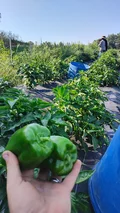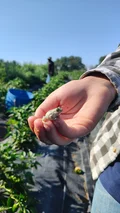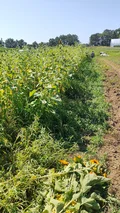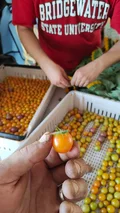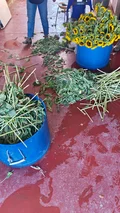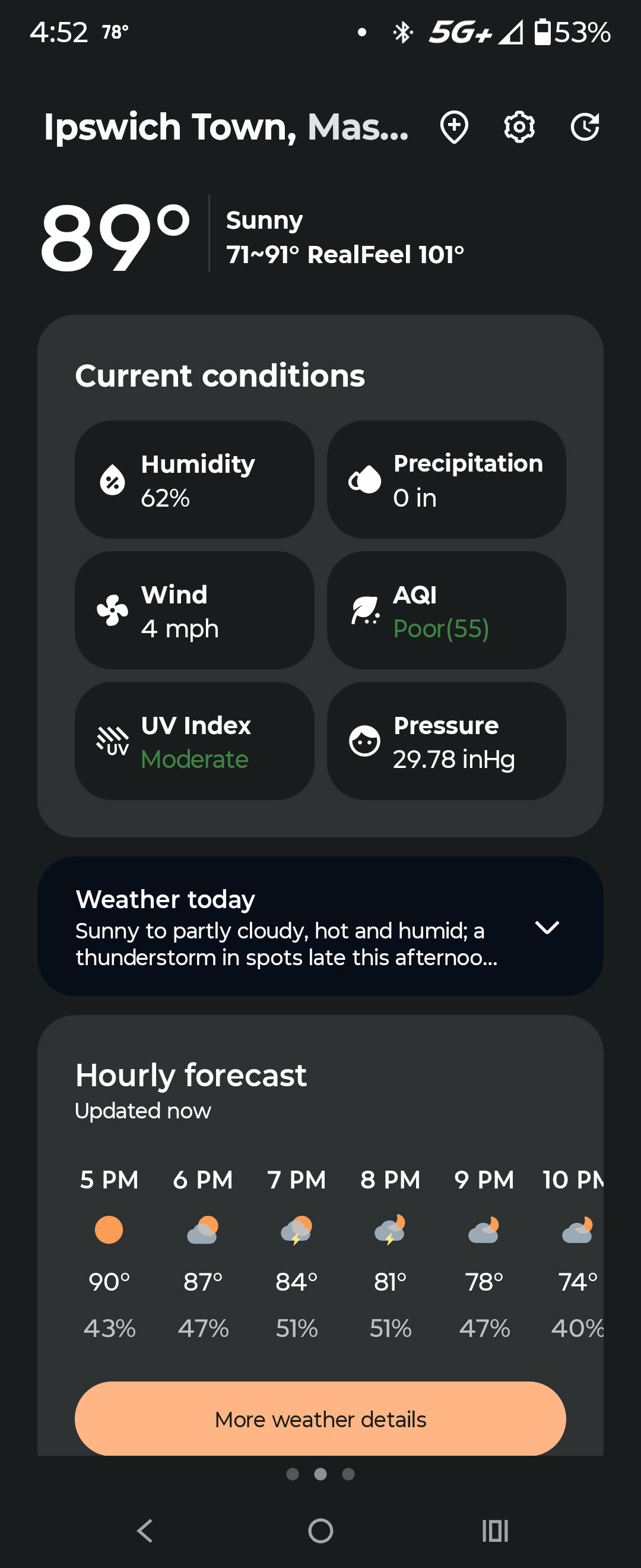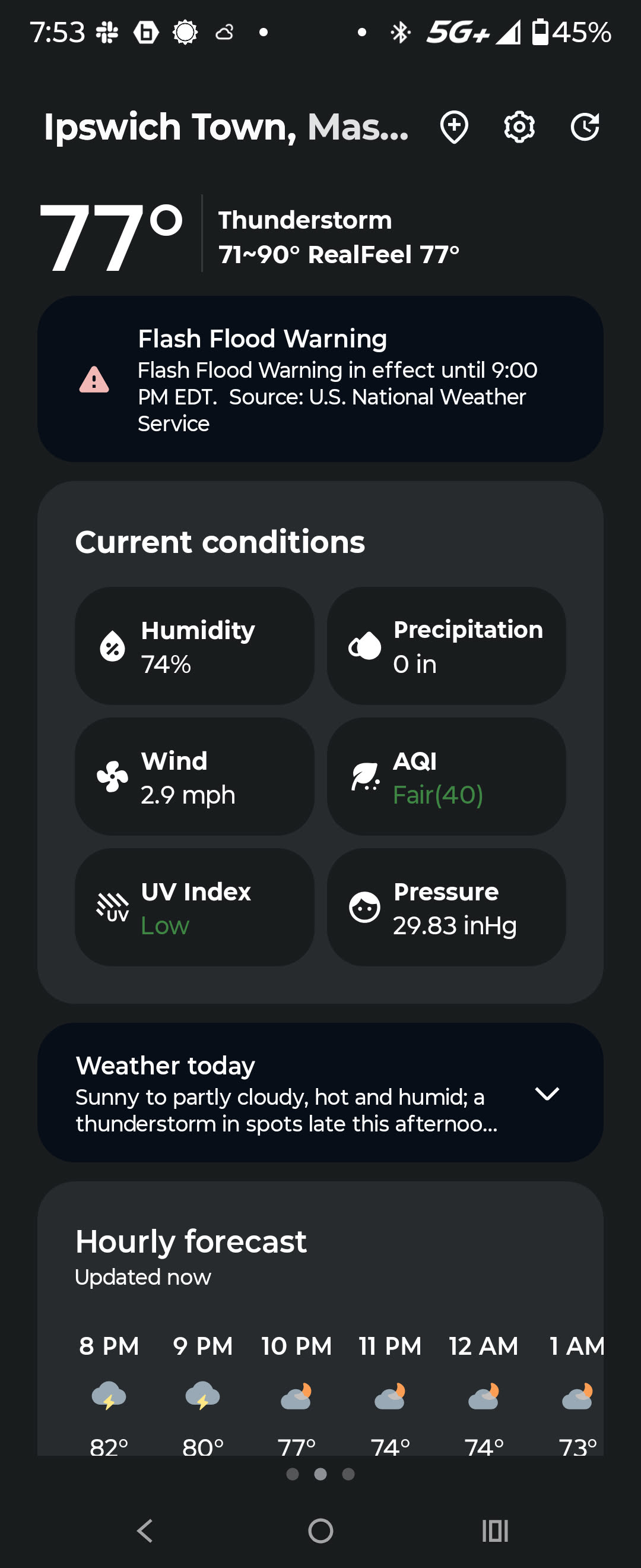TL;DR
With the farmer back from vacation, the team is busy harvesting and delivering fresh organic produce to customers during the third heat wave this season this week. While we are sweating and working hard, we are also enjoying the fresh air and exercise in the 11th week of a 20 week CSA, so there’s not much to cover other than what’s already been blogged about over the past few months.
There’s also one or two moments in the day to appreciate the beauty of the farm and the work that goes into it, such as these little blue flowers that close up every day shortly after the sun comes out.
I wanted to take some time this week to step back and exercise my other muscle, my brain, using an example snapshot of the things I’ve learned that go in to what it takes to get all this produce to the farmer’s markets around this area. Mindful of the fact that I’ve only been farming for one whole season but under the tutelage of a seasoned farmer, I’m sure there are many things I’ve missed or overlooked.
Be that as it may, the average produce customer might find it interesting to know how much work goes into getting them juicy tomatoes in August or sweet carrots in October, with our efforts starting in the winter and ending shortly before the next one.
What It Takes to Get Produce to a Farmer’s Market (or CSA)
While this is not an exhaustive list, I want to highlight how much work goes into getting produce to market, starting in the winter and ending shortly before the next one.
Planning (Jan-Feb)
- Establishing the baseline of targets, projected revenue, input costs, new expenditures
- Identifying what worked last year, what didn’t, and what to do about that in the new year
- Comprehensive financial review, tax preparation, and other legal and regulatory compliance
- Alignment across management personnel on the farm’s goals, priorities, and budget
- Plan details adjustment given final target agreements and budget
Commitment (Feb-Mar)
- Ordering seeds, supplies, equipment, livestock, and other inputs
- Scheduling pre-season equipment maintenance and repairs
- Nursery greenhouse preparation and early indoor seed starting (onions, lettuces, etc.)
- Early plot and bed preparation (as soon as soil is workable)
- CSA, distributor, and channel partner communications
Planting (Mar-May)
- Planting of early cool-season crops (lettuce, spinach, etc.)
- Planting of long-cycle, mid-season crops (potatoes, onions, etc.)
- Seeding and watering trays in nursery greenhouse on a daily basis
- Pruning and tracking growth of nursery greenhouse plants (onions, tomatoes, etc.)
- Bed preparation (cultivation, amendment, marking)
- Application of landscape fabric, mulch, and row cover to specific crop beds
Harvesting and Maintenance (May-Nov)
- Harvesting: picking, sorting, packing, and transporting
- Processing: cleaning, washing, and packaging
- Distribution to pickup and markets multiple times a week
- Trellising, pest reduction, pinching
- Planting, re-planting, direct seeding
- Weeding, lots and lots of weeding
- Watering and irrigation maintenance
- Nursery seed tray preparations for fall crops (winter squash, leafy greens, etc.)
- Honey collection, separation, and jarring
Growing Season Close (Nov-Dec)
- Retraction and storage of winter-unsafe equipment (irrigation, etc.)
- Consolidation of field resources (row cover, landscape fabric, staples, spikes)
- Collecting soil samples for mail-order laboratory testing
- Storage: preserving, storing, and rotating winter inventory (e.g. meat share products)
- Accounting: year-end close and financial reconciliations
Exhausting but not Exhaustive Experience Yet
Working on any farm is physically exhausting. In Massachusetts and on this farm, it’s worth it for me both personally and (future) professionally. The more I work it, the more I see how much more there is to learn. I tend to gravitate to the scientific stuff, the soil microbiology and operational process-based knowledge, but there’s a deeper (than this skin-deep) level of understanding about what it takes to do this work long-term that still has many years to develop.
In conversation this week, I responded twice to different inquiries about whether or not I would look towards managing farm operations as a more longer-term career option with “I haven’t arrived at that determination yet, there’s a lot to still know.” To anyone in management, that should be telling. There’s apprehension about if and how I could do so, but also should and must I be doing this kind of work. Many others are more qualified, but most aren’t driven to put in the same relentless and dedicated effort as what it takes.
Some climbers, when looking at the face of a mountain think two ways: 1) how should this be best done, and 2) what would it take for/from me to do it? I am asking those questions about farming now, not despite of the challenge, but because of the economic implications. My love of nature and it’s constant demand for growth (genetically and personally) compel me to continue this work. It is a trend, not a blip (thanks for that, Jamie).
Run-away Blips in AI Processes
After listening back to yesterday’s AI-generated summary, there were a few minor retractions, particularly around the topic of ‘peppers’ since it didn’t quite seem to pick up on my specific references to how hot peppers don’t move very fast…because they’re spicy and there’s only so many you need per week. It seemed to get confused about why ‘peppers’ don’t sell as fast as other vegetables.
Three characters…‘hot’…that’s all it takes to miss the point. This is another reason why the future of my technology work in this space will necessarily involve a custom LLM and/or embeddings specific to agriculture and organic farming. Imagine how many of these small misses were included in farm operations and planning cycles…confusions between farmer, crews, and business manager?
There’s no AI today that can account for all the complexities of running a farm, but there are specific use cases emerging out of my work on the crew that are less monolithic and more specialized to areas of operations. For today, the main public one is the daily notes as evidenced by the summaries on this blog, of which today’s is below:
AI Summary from Field Notes
Main Themes:
- Farming Work: Daily tasks like feeding, watering, and harvesting crops.
- Nature Observation: Noticing natural behaviors (e.g., flowers closing at 9:30 AM).
- Team Collaboration: Interactions with colleagues, the owner, and shared responsibilities.
- Reflection on Labor: Emphasis on the value of hard work and the farm’s impact on individuals.
Activities Performed:
- Fed and watered chickens and pigs.
- Harvested peppers, cherry tomatoes, and sunflowers.
- Processed sunflowers by stripping leaves and chopping.
- Assisted with deliveries, truck loading/unloading, and market prep.
- Helped find a lost phone for a colleague.
- Participated in a team birthday celebration.
- Cleaned up and prepared for market activities (e.g., irrigation, van packing).
- Unloaded CSA members’ produce at the Ipswich pickup location.
New Discoveries/Unfamiliar Aspects:
- Sunflower Processing Technique: A specific method for efficiently removing leaves from sunflowers.
- Flower Behavior: Observation of flowers closing at 9:30 AM, a natural phenomenon.
- Social Dynamics: The farm’s role in community events (e.g., birthdays) and team interactions.
Questions for Future Research:
- How can the sunflower processing technique be optimized for larger operations?
- What causes the flowers to close at 9:30 AM, and is this species-specific?
- How does the farm’s environment influence workers’ well-being?
- What are the implications of the farm’s role in facilitating shared tasks (e.g., finding a lost phone)?
Suggested Actions:
- Document the sunflower processing method for potential replication.
- Monitor flower behavior over time to study circadian rhythms or environmental triggers.
- Investigate how team dynamics (e.g., birthdays, shared tasks) affect morale and productivity.
- Analyze market logistics (e.g., delivery efficiency) for improvements.
Part 1
Main Themes:
- Farming Work and Labor: The intern describes the physical tasks involved in farm work, including feeding, watering, and harvesting crops.
- Observation of Nature: The intern reflects on the natural behavior of flowers (closing at dawn) and the interaction between humans and the environment.
- Team Collaboration: The intern works with others, including Paolo, the owner, and peers, highlighting teamwork and social interactions.
- Reflection on Hard Work and Value: The intern emphasizes the importance of hard work, the balance between labor and life, and the positive impact of the farm on individuals.
Activities Performed by the Intern:
- Fed and watered chickens and pigs.
- Harvested peppers, cherry tomatoes, and sunflowers.
- Processed sunflowers by stripping leaves and chopping them.
- Assisted with deliveries and loading/unloading trucks for markets.
- Helped find a lost phone for a colleague.
- Participated in a birthday celebration for a team member.
- Cleaned up and prepared for market activities (e.g., irrigation, packing the electric van).
- Unloaded CSA members’ produce at the Ipswich pickup location.
New Things Not Yet Encountered:
- Sunflower Processing Technique: The intern describes a specific method for efficiently removing leaves from sunflowers (using fingers to strip leaves quickly).
- Flower Behavior: The intern notes the flowers closing at 9:30 AM, a natural observation not previously mentioned in their notes.
- Social Dynamics: The intern reflects on the birthday celebration and the owner’s involvement, highlighting the farm’s social and community aspects.
Questions and Future Research Areas:
- Sunflower Processing Efficiency: Could the described technique be optimized further for large-scale operations?
- Flower Behavior: What causes the flowers to close at 9:30 AM, and is this species-specific?
- Impact of Farm Work on Individuals: How does the farm’s environment influence the mental and physical well-being of workers?
- Lost Phone Incident: What are the implications of the farm’s role in helping someone recover a lost item?
Suggestions for Action:
- Document Sunflower Processing: Record the sunflower leaf-stripping technique for future reference or training.
- Track Flower Behavior: Monitor the flowers’ behavior over time to understand their circadian rhythms or environmental triggers.
- Explore Team Dynamics: Investigate how the farm’s social interactions (e.g., birthdays, shared tasks) affect team morale and productivity.
- Evaluate Market Logistics: Analyze the efficiency of the delivery and unloading processes for potential improvements.
[end of post]
Enjoy Reading This Article?
Here are some more articles you might like to read next:


